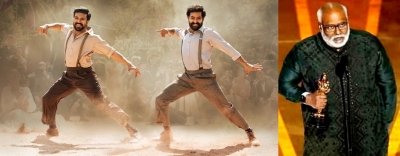By Vinod Mirani
This is the time to juxtapose the various regional film industries with those in South India. Especially at a time when South Indian films not only feed Hindi films through remakes or dubbed films, but when even globally acclaimed Hollywood filmmakers are acknowledging their importance.
‘RRR’ has struck a chord with foreign audiences and its song, ‘Naatu Naatu’, with the Academy of Motion Picture Arts & Sciences, which awards the Oscars. Wish there was a category for choreography as well at the Oscars, for, I think, that has created the magic that ‘Naatu Naatu’ has become known for.
We had Richard Attenborough’s ‘Gandhi’ and, later, Danny Boyle’s ‘Slumdog Millionaire’, both of which made it big at the Oscars. We were thrilled about it. But they were not the products of any of the Indian film industries. They merely had India-related stories.
Quite a few other filmmakers tried for nominations at the Oscars
The earlier one was Mehboob Khan’s ‘Mother India’. They probably did not identify with a woman refusing to compromise even while her kids were starving. It was the post-World War II era and there were stories about women known to compromise for as little as a pack of cigarettes!
The film ‘RRR’ and its music, especially ‘Naatu Naatu’ and the way it is choreographed, caught the fancy of people all over the world. The song became a new anthem for dance lovers. Hollywood dance-based musicals with the likes of Fred Astaire, Ginger Rogers and Gene Kelly and later films such as ‘Sound Of Music’, ‘Fiddler On The Roof’, ‘Cabaret’, ‘Grease’, ‘Saturday Night Fever’ and ‘Chicago’ are rare now.
The song ‘Naatu Naatu’ probably reminded dance lovers of the Fred Astaire days. This one was kind of a tap dance at a fast pace with much more energy in keeping with the times!
So, if the regional films from the South — in Telugu, Tamil, Kannada and Malayalam — have sustained over the decades and, at many times, their themes are also loved by the audience when remade or dubbed in Hindi, why have the other regional language films not been able to penetrate the audience in other regions, let alone foreign shores?
Take for example, Punjabi films. Earlier, the few Punjabi films that were produced from time to time were made by mostly regular Hindi filmmakers. From the biggest hit of the 1970s, ‘Nanak Naam Jahaj Hai’, to the recent hit, ‘Char Sahibzaade’ (animated) were produced, for instance, by Pannalal Maheshwari (he made Hindi films such as ‘Neel Kamal’ and ‘Kaajal’) and Harry Baweja (‘Dilwale’, ‘Diljalle’, etc), respectively.
Now the scene is totally different. Many producers have made Hindi films with a heavy bent towards the usage of Punjabi dialogue and Punjabi music, but they don’t make films especially for the Punjabi-speaking audience.
Punjabi films are mostly backed by NRI moneybags from Canada and the UK. The dollar-to-rupee exchange rate is the major lure here. Rest of the fringe benefits are the same all over: pictures in local media, friendship with stars and the urge to make a name. There is no dearth of financiers, but there is little Punjab in these films except the language. Presently, there are as many as 40 films ready for release, but there are no buyers.
The Gujarati film industry always belonged, save for a rare few, to the non-Gujarati filmmakers from Mumbai. Even the sole film processing laboratory set up in Gujarat belonged to a Mumbai lab owner who had transferred all his old machinery to set up a lab in Gujarat; laws were devised so that it was mandatory to work with a Gujarat lab!
They picked mostly Kathiawadi folklore from the Saurashtra region for both the stories and the songs of these films. What these films drew was only the lowest strata of the audience. No middle class family ever entered the cinemas screening these films. To top it all, the films enjoyed entertainment tax exemption as a rule and was not merit based.The industry survived for some years.
With the new generation and technical advances, the Gujarati films are in the process of reviving. Films such as ‘Chhello Show’ (The Last Show, India’s official entry for the 95th Academy Awards) and ‘Hellaro’ (The Outburst) won National Awards and with the success of some early releases, it looked like the Gujarati film industry was on the revival path.
Some new investors were roped in. So far so good, but the roping in of a backer has now turned into a racket. The nouveau riche and glamour struck are shown rosy pictures all the way till a film’s release.
Once a film is complete, a five-screen premiere is organised in Mumbai, instead of Ahmedabad, followed by a party. Some Rs 25 lakh goes into these premature celebrations. When the film releases, it fails to cover these costs spent on making the investor feel good.
Now the Gujarati industry is delivering flops on a regular basis.
Coming to Marathi films, they did well in the era of Ashok Saraf, Laxmikant Berde, Mahesh Kothare, Sachin, Nilu Phule and Dada Kondke, who did mostly romantic comedies. Before that, the films were based on feudal themes. As of now, there is no set trend.
A formula love story, ‘Sairat’, went on to become the biggest hit in 2016 (a rare Marahi film to cross Rs 100 crore) and it took six more years for another film, Riteish Deshmukh’s ‘Ved’, to come somewhere close with around Rs 75 crore. The major problem with Marathi films is that the producer has to also distribute the film as there are no regular distributors.
The Bhojpuri film industry has somewhat similar stories as Gujarati and Punjabi films. The backers of these films are mostly prospect hunters.
There came a phase when the Hindi films that Mumbai produced were beyond the comprehension of the audience in other states, especially in Eastern UP, Bihar and Chhattisgarh, which had their own vibant culture.
There was a time when the Hindi filmmakers tried to imitate the Western culture and even took to shooting their films abroad. This phase sort of revived some regional industries, notably Punjabi and Bhojpuri.
Then there are Bengali films. They have their own audience and rarely, if ever, go beyond the state. Yes, there was a time when a lot many Bengali producers and actors were active in Mumbai and often remade Bengali films in Hindi when not making a Hindi-Bengali bilingual. Not to forget, Bengali makers were also the favourites of the givers of National Awards!
The major drawbacks with these regional films is that they have no or limited market outside of their own state. Also, while the budgets for making a film has grown into crores, there is little support from the overseas, satellite and OTT markets.
The other factor that works against them is that people in these states understand and follow Hindi films as much as their own regional films. As such, they end up competing with Hindi films.
In the South, the exploitation of movie goers is controlled as there is a restriction on admission rates charged. In other regions, they pay as much as they would for Hindi mainstream films.
The main reason is that when one regional film works, the scene gets crowded and production activities mushroom suddenly leading to oversupply much beyond demand.
–IANS
vinod/srb





